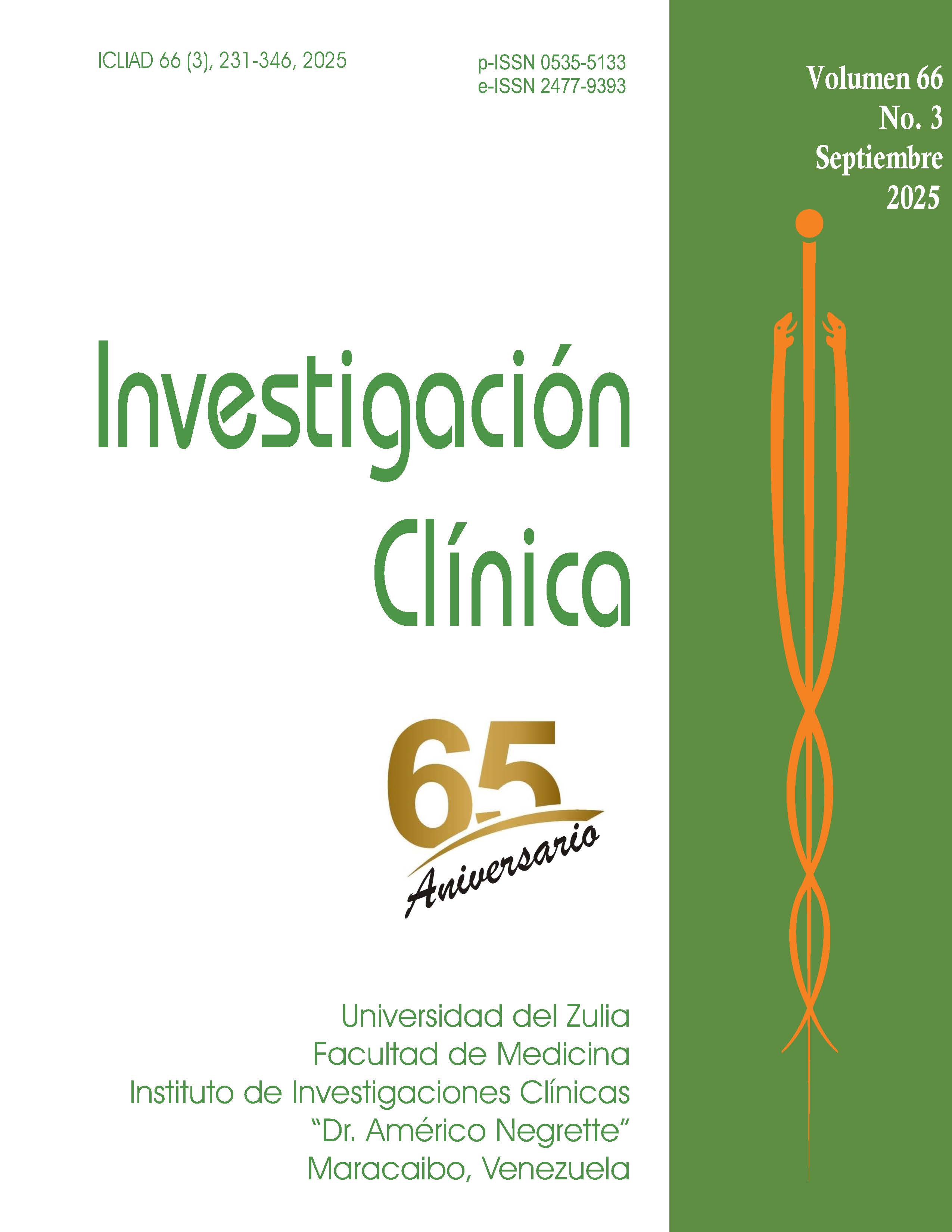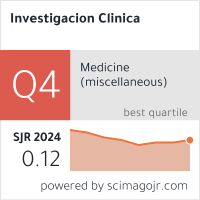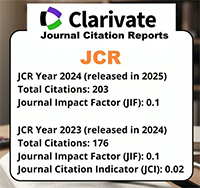Condiciones comórbidas del síndrome de West y autismo: Reporte de 5 casos.
Comorbid conditions of West syndrome and autism: Report of five clinical cases.
Abstract
West syndrome (WS) is an epileptic encephalopathy characterized by infantile spasms (IS), psychomotor delay or regression, and a typical EEG pattern called Hypsarrhythmia. IS are tonic seizures of sudden onset, in flexion, extension, or mixed, of short duration, and in series, which usually occur in the first year of life. It is estimated that at least 20 percent of children with WS develop autism. Both WS and autism spectrum disorders (ASD) share genetic, structural, and metabolic alterations, as well as immune dysfunction, which in- teract with environmental factors, suggesting potential common mechanisms linking both disorders. We performed a retrospective and descriptive analysis of clinical records of five children between the ages of three and seven years, all presenting with IS and clinical signs of ASD. Comprehensive neurological and psychological assessments were conducted, along with EEGs. The average age was 4.4 years, with a predominance of males. The onset of symptoms occurred between four and seven months, and signs of autism were identified between one and 2.5 years. All patients exhibited hypsarrhythmia on their EEGs. Three of the five children had a diagnosis of neurocutaneous syndrome. All were treated with ACTHH or nitrazepam, with a satisfactory response. We highlight the relationship with neurocutaneous syndromes, particularly tuberous sclerosis, where cellular, molecular, and pathophysiological mechanisms may impact neuronal connectivity, thus influencing the epileptogenic process and developmental delay. Early identification of these clinical signs by the pediatrician will allow for timely interventions.
Downloads
References
Paricio-Ubeda M. Revisión Bibliográfica de Síndrome de West. RSI. 2023; 4(2). Dispo- nible en: https://revistasanitariadeinvestigacion.com/revision-bibliografica-del-sindrome-de-west/
Giraldo-Torres LR, Restrepo-Mejía FR, Arboleda-Sánchez VA. Trastorno del espectro autista. Electroencefalografía y neuronas espejo. Acta Neurol Colomb. 2018; 34(3):215-222. https://doi.org/10.22379/24224022215GICOS/2022.07.01.10.
Palau-Baduel M, Valls-Santasusana A, Salvadó-Salvadó B, Clofent-Torrentó M. Aportación del electroencefalograma en el autismo. Rev Neurol. 2013; 56(S1): 35-43. https://doi.org/10.33588/rn.56S01.2012653
Koul R. Hypsarrhytmia and triphasic waves seem to be akin (similar) age-dependent responses of the brain to different insults. J Neurosci Rural Pract 2024; 15(1): 156-158. https://doi.org/10.25259/ JNRP_319_2023.
Ruggieri V. Regresión autista aguda. Pediatr Panama.2017; 46 (2): 105-111. Disponible en: https://docs.bvsalud.org/biblio-ref/2017/08/848344/105-111.pdf
López-Cruz C, Cano-López F, Aliño M, Puig-Pérez S. Síndrome de West y trastorno del espectro del autismo asociado: una propuesta de protocolo de evaluación e intervención neuropsicológica. Pap Psicol 2022; 43(2): 125-132. https://doi.org/10.23923/pap.psicol.2981
Kenney-Jung DL, Rogers DJ, Kroening SJ, Zatkalik AL, Whitmarsh AE, Roberts AE, et al. Infantile epileptic spasms syndrome in children with cardiofaciocutanous syndrome: clinical presentation and associations with genotype. Am J Med Genet C Semin Med Genet 2022; 190(4): 501-509. https://doi.org/10.1002/ajmg.c32022.
Horta-Martínez LE, Piñera-Castro HJ, Sorá-Rodríguez M, Rodríguez-López A, Maragoto-Rizo C. Comorbilidad del trastorno el espectro autista y la epilepsia en edades pediátricas. Rev Cubana Pediatr. 2023; 95. Disponible en: http://scielo.sld.cu/scielo.php?script=sci_arttext&pid=S0034-75312023000100003&lng=es.
Garcia-García RJ, Robinson-Agramonte MA. Comorbilidad en pacientes con trastornos del neurodesarrollo. Rev Cubana Pediatr. 2020; 92(4). Disponible en: http://scielo.sld.cu/scielo.php?script=sci_arttext&pid=S0034-75312020000400010&lng=es.
Hu C, Liu D, Luo T, Wang Y, Liu Z. Phenotypic spectrum and long-term outcome of children with genetic early-infantile-onset developmental and epileptic encephalopathy. Epileptic Disord. 2022; 24 (2): 343-352. https://doi.org/10.1684/epd.2021.1394
Kanner L. Autistic Disturbances of affective contact. Nervous Child. 1943; 2 (3):217-250. Disponible en: https://autismtruths.org/pdf/Autistic%20Disturbances%20of%20Affective%20Contact%20-%20Leo%20Kanner.pdf
Artigas-Pallares J, Paula I. El Autismo 70 años después de Leo Kanner y Hans Asperger. Rev Asoc Esp Neuropsiq.2012;32(115): 567-587. https://dx.doi.org/10.4321/S0211-57352012000300008.
Núñez-Contreras P, Granado-Rocha D, Carvajal-Game M, Torres-Pérez A. Aspects of neurodevelopment between autism spectrum disorders and epilepsy. Rev Mex Neurocienc. 2022; 23(5): 183-191. https://doi.org/10.24875/rmn.20000055.
Bitton JY, Demos M, Elkouby K, Connoly M, Weiss SK, Donner EJ, et al. Does treatment have an impact on incidence and risk factors for autism spectrum disorders in children with infantile spasms? Epilepsia. 2015; 56(6): 856-863. https://doi.org/10.1111/epi.12997.
Ruggieri V, Arberas C. Importancia de la dismorfología en la identificación de entidades médicas asociadas. Rev Neurol. 2017; 64 (S1): 27-31. https://doi.org/10.33588/RN.64S01.2017010.
Yuskaitis CJ, Ruzhnikov MRZ, Howell KB, Allen IE, Kapur K, Dlugos DJ, et al. Infantile spasms of unknown cause: predictors of outcome and genotype-phenotype correlation. Pediatr Neurol. 2018; 87:48-56. https://doi.org/10.1016/j.pediatrneu-rol.2018.04.012.
Pavone P, Striano P, Falsaperla R, Pavone L, Ruggieri M. Infantile spasms syndrome West and related phenotypes: What we know in 2013. Brain Dev. 2014; 36(9):739-751. https://doi.org/10.1016/j.braindev.2013.10.008.
Wolff M, Brunklaus A, Zuberi SM. Phenotypic spectrum and genetics of SCN2A- related disorders, treatment options and outcomes in epilepsy and beyond. Epilepsia. 2019; 60(S3): S59-S67. https://doi.org/10.1111/epi.14935.
Reynolds C, King MD, Gorman KM. The phenotypic spectrum of SCN2A-related epilepsy. Eur J Paediatr Neurol. 2020; 24: 117-122. https://doi.org/10.1016/j.ejpn.2019.12.016.
Sanders SJ, Campbell AJ, Cottrell JR, Moller RS, Wagner FF, Auldridge AL, et al. Progress in understanding and treating SCN2A- mediated disorders. Trends Neurosci. 2018. 41(7): 442-456. https://doi.org/10.1016/j.tins.2018.03.011.
Muñoz-Yunta JA, Palau-Baduel B, Salvadó-Salvadó A, Valls-Santasusana N, Rosendo- Moreno M, Clofent-Torrentó M, Manchado F. Autismo, epilepsia y genética. Rev Neurol. 2008; 46 (S1): S71-S77. https://doi.org/10.33588/rn.46S01.2008012.
Tuchman R. What is relationship between autism spectrum disorder and epilepsy. Semin Pediatr Neurol. 2017; 24(4): 292-300. https://doi.org/10.1016/j.spen.2017.10.004.
Zarakoviti E, Shafran R, Skuse D, Mc Tague A, Batura N, Palmer T, et al. Factor associated with the occurrence of epilepsy en autism: a systematic review. J Autism Dev Disord. 2023;53(10):3873-3890. https://doi.org/10.1007/s10803-022-05672-2.
Lee BH, Smith T, Paciorkowski AR, Autism spectrum disorder and epilepsy: Disorders with a shared biology. Epilepsy Behav. 2015; 47: 191-201. https://doi.org/10.1016/j.yebeh.2015.03.017.
Ruggieri V, Arberas CL. Mecanismos epigenéticos involucrados en la génesis del autismo. Medicina (B. Aires). 2022; 82(S1): 48-53. Disponible en: https://www.scielo.org.ar/scielo.php?script=sci_arttext&pid=S0025-76802022000200048&lng=es.
Castillo-Batista M, Ortega-Rodríguez D, D’llio-Gil H. Papel de la epigenética en el origen del autismo. RECIMUNDO. 2023;7(3):228-237. https://doi.org/10.26820/recimundo/7.(3).sep.2023.228-237
Nagarajan B, Gowda VK, Yoganathan S, Sharawat IK, Srivastava K, Vora N, et al. Landscape of genetic infantile epileptic spasms syndrome. A multicenter cohort of 124 children from India. Epilepsia Open. 2023; 8(4): 1383-1404. https://doi.org/10.1002/epi4.12811
Vidaurre J. Síndromes epilépticos genéticos. Pediatr Panama. 2017; 46(2): 68-74. Disponible en: https://docs.bvsalud.org/biblioref/2017/08/848353/sindromes-epilepticos-geneticos.pdf
Snyder HE, Jain P, RamachandranNair R, Jones KC, Whitney R. Genetics advancements in infantile spasms syndrome and opportunities for precision medicine. Genes. 2024; 15(3): 266. https://doi.org/10.3390/genes15030266
Goswami M, Sharma S. West syndrome – infantile spasms: A pediatric case report. Int J Clin Pediatr Dent. 2021; 14(2):323-326. https://doi.org/10.5005/jp-journals-10005-1922
Ren LH, Zhang J, Li SK, Liu P, Chen H, Hu W. Infantile epileptic spasms syndrome: a cohort study of 88 children. Ital J Pediatr. 2023; 49(1): 159. https://doi.org/10.1186/s13052-023-01563-z.
Zeng B, Zhang H, Lu Q, Fu Q, Yan Y, Lu W, et al. Identification of the five novel SCN1A variants. Front Behav Neurosci. 2023; 17:1272748. https://doi.org/10.3389/fnbeh.2023. 1272748
Bezag FMC, Vasey MJ. Seizures and epilepsy in autism spectrum disorder. Psychiatr Clin North Am. 2021; 44(1): 51-68. https://doi.org/10.1016/j.psc.2020.11.005
Muñoz N, Patiño O, Aponte A, Barrera M, Reyes M, Moneriz C. Síndrome de West: reporte de caso y aspectos moleculares de tratamiento. Revista Ciencias Biomédicas. 2022; 11(4):291- 296. http://doi.org/10.32997/rcb-2022-3804.
Demarest S, Calhoun J, Eschbach K, Yu HC, Mirsky D, Angione K, et al. WES Support Group. Whole-exome sequencing and adrenocorticotropic hormone therapy in individuals with infantile spasms. Dev Med Child Neurol. 2022; 64(5): 633-640. https://doi.org/10.1111/dmcn.15109.
Torres López DA. Detección temprana del trastorno del espectro del autismo en la escuela. Eduscientia. Divulgación de la ciencia educativa. 2019;2(3):16-23. Disponible en: https://www.eduscientia.com/index.php/journal/article/view/36
Calderón-Romero M, Arce-Portillo E, López-Lobato M, Muñoz-Cabello B, Blanco- Martínez B, Madruga-Garrido M Alonso-Luego O. Síndrome de West criptogénico: perfil clínico, respuesta al tratamiento y factores pronóstico. An Pediatr. 2018; 89(3): 176-182. https://doi.org/10.1016/j.anpedi.2017.10.012
Cano-Villagrasa A, Moya-Faz F, Porcar-Gozalbo N, López-Zamora M. Treatment options in autism with epilepsy. Child Adolesc Psychiatry. 2024; 22:3:1265081. https://doi.org/10.3389/frcha.2024.1265081
Ewen JB, Marvin AR, Law K, Lipkin PH. Epilepsy and autism severity: a study of 6975 children. Autism Res. 2019; 12(8):1251-1259. https://doi.org/10.1002/aur.2132
Peña J. West syndrome. En Classic Eponyms in Child Neurology. A comprehensive Guide to Diagnosis and Management. ISBN-13: 979-8870950044, 2023; 267-279.





















